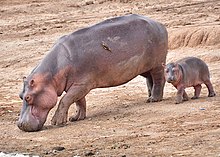American Hippo bill


House Resolution 23261, also known as the "American Hippo bill", was a bill introduced by Representative Robert F. Broussard of Louisiana in 1910 to authorize the importation and release of hippopotamus into the bayous of the state.[1][2]
Overview[edit]
Broussard argued the hippos would eat the invasive water hyacinth that was clogging the rivers and also produce meat to help solve the American meat predicament.[2][3] The chief collaborators and proponents of Broussard's bill were Major Frederick Russell Burnham and Captain Fritz Duquesne.[4][5] Former President Theodore Roosevelt backed the plan, as did the U.S. Department of Agriculture, The Washington Post, and The New York Times, which praised hippo meat as "lake cow bacon".[6][4] William Newton Irwin, a researcher for the United States Department of Agriculture recruited by Broussard, told Congress that the bill could add one million tons of meat to the yearly American supply, and further suggested that more exotic animals should be imported for the same purpose, including dik-diks, rhinoceroses, African buffalo, Tibetan yaks, and Manchurian pigs.[7]
Although the "American Hippo Bill" developed a broad base of support, it was never passed by the US Congress.[2]
In popular culture[edit]
Author Sarah Gailey's River of Teeth series depicts an alternate history United States in which the American Hippo bill was passed.[8]
See also[edit]
References[edit]
- ^ Miller, Greg (20 December 2013). "The Crazy, Ingenious Plan to Bring Hippopotamus Ranching to America". Wired. ISSN 1059-1028. Archived from the original on 17 January 2015.
- ^ a b c Mooallem, John (2013). American Hippopotamus. New York: The Atavist. Archived from the original on 30 January 2022. Retrieved 7 March 2014.
- ^ Mooallem, Jon (10 August 2014). "Lake Bacon: The Story of The Man Who Wanted Us to Eat Mississippi Hippos". The Daily Beast. ISSN 0028-9604. Retrieved 13 August 2014.
- ^ a b Eplett, Layla (27 March 2014). "The hunger game meat: How hippos early invaded American cuisine". Scientific American. ISSN 0036-8733.
- ^ Burnham, Frederick Russell (1944). Taking Chances. Los Angeles: Haynes Corp. pp. 11–23. ISBN 978-1-879356-32-0.
- ^ "Lake Cow Bacon". The New York Times. 12 April 1910.
- ^ Parks, Shoshi. "How the U.S. Almost Became a Nation of Hippo Ranchers". Smithsonian Magazine. Retrieved 2024-05-30.
- ^ Gailey, Sarah (2018-05-22). American Hippo: River of Teeth, Taste of Marrow, and New Stories. Tordotcom. ISBN 978-1-250-17643-1.
Further reading[edit]
- Ratliff, Evan, ed. (2016). Love and Ruin: Tales of Obsession, Danger, and Heartbreak from The Atavist Magazine. Introduction by Susan Orlean. W. W. Norton. ISBN 978-0393352719.
